This article was co-authored by Heather Richmond, MD. Dr. Heather Richmond, MD is a board certified Dermatologist at Dermatology and Laser Surgery Center in Houston, Texas. With over nine years of experience, Dr. Richmond specializes in comprehensive dermatology including medical, surgical, and cosmetic procedures. She graduated cum laude from Yale University with a BA in Molecular, Cellular, and Developmental Biology. She earned her MD from the University of California, Irvine School of Medicine, where she was inducted into the Alpha Omega Alpha Honor Medical Society. She completed her Internal Medicine internship at Cedars-Sinai Medical Center and her Dermatology residency at The University of Texas MD Anderson Cancer Center in Houston. Dr. Richmond is a fellow of the American Academy of Dermatology and is a member of the American Society for Dermatologic Surgery, American Society for Laser Medicine and Surgery, and the Texas and Houston Dermatological Societies.
There are 13 references cited in this article, which can be found at the bottom of the page.
This article has been viewed 54,457 times.
Eczema and psoriasis are conditions that affect the skin. They both produce red areas or bumps on the skin, so they can be difficult to tell apart. Eczema starts earlier in life and usually causes more itching, while psoriasis develops later and is characterized by thick patches of skin.[1] Learn how to tell the difference between eczema and psoriasis so you can get the proper treatment.
Steps
Identifying Eczema
-
1Monitor for red-brown patches. Eczema and psoriasis both cause red patches on the skin; however, eczema has red patches that may also have a brownish or gray tint to them. The skin may also be covered in smaller bumps that are filled with fluid or that are crusty.[2]
- The red patches of skin may be covered in raised bumps that look like goosebumps.
- The affected skin may thicken or develop knots.
- The color may be darker or lighter depending on the type of eczema, how long it has been affecting you, or how serious the flare up is.
-
2Check for dry skin. Eczema often makes your skin dry.[3] Your skin may be flaky or peel off when scratched. In extreme cases, the skin may be cracked because it is so dry.[4]
- The skin may crack and ooze a clear substance. The cracked skin may lead to skin infections.
Advertisement -
3Identify where eczema occurs. Eczema often occurs on the inside of the elbows, the back of the knees, the wrists, and the ankles.[5]
- In babies, eczema tends to start as red, wavy plaques on the face, especially on the cheeks. It might also appear on the scalp and the outer areas of the arms and legs.
- Later in childhood, eczema will become more localized in the arms, especially the bend of the elbow, as well as the bend of the knee, and sometimes the neck and face.
Recognizing Psoriasis
-
1Look for red patches of skin. The most common symptom of psoriasis is thick, scaly, raised red patches of skin.[6] The patches of red skin are covered with silver-colored or white scales. A different type of psoriasis may have small red spots all over the skin. Psoriasis may also cause swollen red areas of the skin or bumps with pus.[7]
- The raised scaly patches of skin are extremely dry. The patches may crack and bleed.
- Pus-filled bumps will dry out and may turn brown or become scaly.
-
2Notice the areas where afflicted. Where the red areas appear on your skin depends on the type of psoriasis you have. Psoriasis can happen pretty much any place on your body. If you have the large, thick silvery-red scales, this can be anywhere, including your mouth or genitals. Mostly it forms on the knees, elbows, lower back, and scalp.[8]
- Guttate psoriasis causes small red bumps mostly occur on the torso, back, arms, legs, and scalp.
- Inverse psoriasis gives you patches of red skin along the folds of your skin, such as on your armpits, groin, under the breasts, along your buttocks, and around your genitals.[9]
- You may also get psoriasis of the nails or hands. Pustular psoriasis may only affect the palms or the soles of the feet.
- In babies, psoriasis may occur first on the face or the diaper area. In children and adults, you're more likely to see it on the knees and elbows.
-
3Check for pain. Psoriasis sometimes causes pain. The red patches on your skin may have a burning sensation or become sore and tender. Some bumps may cause blisters that are painful to touch or throb. You may also experience swollen or painful joints.[10]
- Some psoriasis may leave the skin feeling raw and achy.
- Psoriasis tends to be less itchy than eczema.
- You may also have pain due to psoriatic arthritis, which is inflammation of the joints—it's similar to rheumatoid arthritis.[11]
-
4Determine if there was a related cause. Some psoriasis may occur after or alongside other conditions. Some types of psoriasis, such as the small red bumps, may show up after certain illnesses like strep throat.[12]
- Some forms of psoriasis may be accompanied by fever, fatigue, chills, muscle weakness, or an overall feeling of sickness.
- Some types of psoriasis are accompanied by rapid heart rates or a rapid pulse.
- Psoriasis is an autoimmune condition, and it can also have genetic components.[13]
- Psoriasis can also be associated with metabolic syndromes such as diabetes, hypertension, or high cholesterol.[14]
Telling Eczema and Psoriasis Apart
-
1Notice when it occurs. Eczema and psoriasis affect people at different times in their life. This can help you determine which condition the person has. Eczema is common in babies and young children. Psoriasis is common in young adults or the elderly. If the condition starts in childhood, it’s probably eczema, but if it starts as a teenager or adult, it’s more than likely psoriasis.
- Eczema may occur in adults, but it mostly occurs in small children. Generally, the eczema gets better as the child grows up.
- Psoriasis is most common between the ages of 15 and 30. It may also begin between the ages of 50 and 60.[15]
-
2Determine the cause. Eczema and psoriasis are triggered by different things. Psoriasis is caused by an unknown underlying reason, but some factors like stress, cold weather, damage to the skin, or medication side effects may cause it. Eczema occurs as a reaction to environmental factors.[16]
- For example, eczema may occur if a person is exposed to allergens like pet dander or hair, jewelry metal, fragrances, detergents, or stress.
- Psoriasis is thought to be caused by genetic factors. It may also be associated with metabolic syndromes, such as diabetes and hypertension.[17] Some triggers such as strep throat, cold, dry weather; or a cut, scratch or sunburn can also trigger psoriasis if you're already genetically predisposed.[18]
-
3Notice the intensity of the itching. Both psoriasis and eczema can cause skin discomfort. The difference in the intensity of the discomfort or itching can provide some insight on which condition the person has.[19] If you have psoriasis, itching the skin may cause the skin or inflamed area to thicken.[20]
Expert Q&A
Did you know you can get expert answers for this article?
Unlock expert answers by supporting wikiHow
-
QuestionWhat does psoriasis look like?
 Heather Richmond, MDDr. Heather Richmond, MD is a board certified Dermatologist at Dermatology and Laser Surgery Center in Houston, Texas. With over nine years of experience, Dr. Richmond specializes in comprehensive dermatology including medical, surgical, and cosmetic procedures. She graduated cum laude from Yale University with a BA in Molecular, Cellular, and Developmental Biology. She earned her MD from the University of California, Irvine School of Medicine, where she was inducted into the Alpha Omega Alpha Honor Medical Society. She completed her Internal Medicine internship at Cedars-Sinai Medical Center and her Dermatology residency at The University of Texas MD Anderson Cancer Center in Houston. Dr. Richmond is a fellow of the American Academy of Dermatology and is a member of the American Society for Dermatologic Surgery, American Society for Laser Medicine and Surgery, and the Texas and Houston Dermatological Societies.
Heather Richmond, MDDr. Heather Richmond, MD is a board certified Dermatologist at Dermatology and Laser Surgery Center in Houston, Texas. With over nine years of experience, Dr. Richmond specializes in comprehensive dermatology including medical, surgical, and cosmetic procedures. She graduated cum laude from Yale University with a BA in Molecular, Cellular, and Developmental Biology. She earned her MD from the University of California, Irvine School of Medicine, where she was inducted into the Alpha Omega Alpha Honor Medical Society. She completed her Internal Medicine internship at Cedars-Sinai Medical Center and her Dermatology residency at The University of Texas MD Anderson Cancer Center in Houston. Dr. Richmond is a fellow of the American Academy of Dermatology and is a member of the American Society for Dermatologic Surgery, American Society for Laser Medicine and Surgery, and the Texas and Houston Dermatological Societies.
Board Certified Dermatologist
-
QuestionCan I treat mild psoriasis at home?
 Mohiba Tareen, MDMohiba Tareen is a board certified Dermatologist and the founder of Tareen Dermatology located in Roseville, Maplewood and Faribault, Minnesota. Dr. Tareen completed medical school at the University of Michigan in Ann Arbor, where she was inducted into the prestigious Alpha Omega Alpha honor society. While a dermatology resident at Columbia University in New York City, she won the Conrad Stritzler award of the New York Dermatologic Society and was published in The New England Journal of Medicine. Dr. Tareen then completed a procedural fellowship which focused on dermatologic surgery, laser, and cosmetic dermatology.
Mohiba Tareen, MDMohiba Tareen is a board certified Dermatologist and the founder of Tareen Dermatology located in Roseville, Maplewood and Faribault, Minnesota. Dr. Tareen completed medical school at the University of Michigan in Ann Arbor, where she was inducted into the prestigious Alpha Omega Alpha honor society. While a dermatology resident at Columbia University in New York City, she won the Conrad Stritzler award of the New York Dermatologic Society and was published in The New England Journal of Medicine. Dr. Tareen then completed a procedural fellowship which focused on dermatologic surgery, laser, and cosmetic dermatology.
FAAD Board Certified Dermatologist
-
QuestionDo I need to see a doctor if I think I have psoriasis?
 Mohiba Tareen, MDMohiba Tareen is a board certified Dermatologist and the founder of Tareen Dermatology located in Roseville, Maplewood and Faribault, Minnesota. Dr. Tareen completed medical school at the University of Michigan in Ann Arbor, where she was inducted into the prestigious Alpha Omega Alpha honor society. While a dermatology resident at Columbia University in New York City, she won the Conrad Stritzler award of the New York Dermatologic Society and was published in The New England Journal of Medicine. Dr. Tareen then completed a procedural fellowship which focused on dermatologic surgery, laser, and cosmetic dermatology.
Mohiba Tareen, MDMohiba Tareen is a board certified Dermatologist and the founder of Tareen Dermatology located in Roseville, Maplewood and Faribault, Minnesota. Dr. Tareen completed medical school at the University of Michigan in Ann Arbor, where she was inducted into the prestigious Alpha Omega Alpha honor society. While a dermatology resident at Columbia University in New York City, she won the Conrad Stritzler award of the New York Dermatologic Society and was published in The New England Journal of Medicine. Dr. Tareen then completed a procedural fellowship which focused on dermatologic surgery, laser, and cosmetic dermatology.
FAAD Board Certified Dermatologist If you just have mild psoriasis, you may be able to treat it by keeping the area moisturized, using salicylic acid, or even getting a little sun.However, if your psoriasis is really itchy and painful, or if it's visible and you're embarrassed, see a dermatologist. Also, if you have psoriatic arthritis, where it affects your joints, you should have that treated right away, because it's a destructive arthritis.
If you just have mild psoriasis, you may be able to treat it by keeping the area moisturized, using salicylic acid, or even getting a little sun.However, if your psoriasis is really itchy and painful, or if it's visible and you're embarrassed, see a dermatologist. Also, if you have psoriatic arthritis, where it affects your joints, you should have that treated right away, because it's a destructive arthritis.
References
- ↑ Heather Richmond, MD. Board Certified Dermatologist. Expert Interview. 15 September 2020.
- ↑ https://www.mayoclinic.org/diseases-conditions/atopic-dermatitis-eczema/symptoms-causes/syc-20353273
- ↑ Heather Richmond, MD. Board Certified Dermatologist. Expert Interview. 15 September 2020.
- ↑ https://www.neosporin.com/eczema/symptoms-signs
- ↑ Heather Richmond, MD. Board Certified Dermatologist. Expert Interview. 15 September 2020.
- ↑ Heather Richmond, MD. Board Certified Dermatologist. Expert Interview. 15 September 2020.
- ↑ https://www.aad.org/public/diseases/scaly-skin/psoriasis#symptoms
- ↑ https://www.mayoclinic.org/diseases-conditions/psoriasis/symptoms-causes/syc-20355840
- ↑ http://www.nhs.uk/Conditions/Psoriasis/Pages/Symptoms.aspx
- ↑ https://www.mayoclinic.org/diseases-conditions/psoriasis/symptoms-causes/syc-20355840
- ↑ Heather Richmond, MD. Board Certified Dermatologist. Expert Interview. 24 September 2020.
- ↑ https://www.aad.org/public/diseases/scaly-skin/psoriasis#causes
- ↑ Heather Richmond, MD. Board Certified Dermatologist. Expert Interview. 24 September 2020.
- ↑ Heather Richmond, MD. Board Certified Dermatologist. Expert Interview. 24 September 2020.
- ↑ https://www.aad.org/public/diseases/scaly-skin/psoriasis#causes
- ↑ https://www.mariobadescu.com/Do-I-have-Rosacea-Eczema-or-Psoriasis#helpme
- ↑ Heather Richmond, MD. Board Certified Dermatologist. Expert Interview. 15 September 2020.
- ↑ https://www.aad.org/public/diseases/scaly-skin/psoriasis#causes
- ↑ https://www.aad.org/public/diseases/eczema/eczema-resource-center/controlling-eczema/eczema-vs-psoriasis
- ↑ https://www.aad.org/public/diseases/scaly-skin/psoriasis
- ↑ https://www.psoriasis.org/advance/when-psoriatic-disease-strikes-the-hands-and-feet/
- ↑ https://www.mayoclinic.org/diseases-conditions/atopic-dermatitis-eczema/symptoms-causes/syc-20353273
- ↑ Heather Richmond, MD. Board Certified Dermatologist. Expert Interview. 15 September 2020.
- ↑ Mohiba Tareen, MD. FAAD Board Certified Dermatologist. Expert Interview. 26 March 2020.
- ↑ Mohiba Tareen, MD. FAAD Board Certified Dermatologist. Expert Interview. 26 March 2020.
About This Article
Eczema and psoriasis are both conditions that affect your skin, but they have slightly different symptoms. Although they both give you red spots, eczema tends to have a brown tint to it, and it can make your skin dry and flaky. Eczema often occurs on your hands, wrists, feet, ankles, upper chest, eyelids, and cheeks. The red patches of psoriasis are often covered with silver or white scales. It usually forms on your knees, elbows, lower back, and scalp, but it can occur anywhere. Although eczema can itch, psoriasis is often more painful with burning sensations or soreness. Eczema tends to start in childhood, while psoriasis usually appears when you’re a teenager or adult. For more information from our Medical co-author, including how to work out the cause of your eczema or psoriasis, read on.

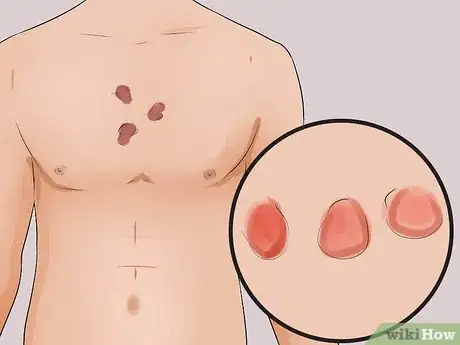
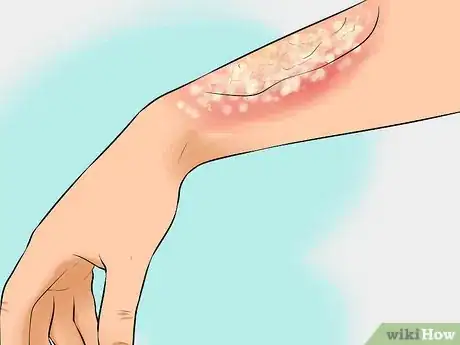
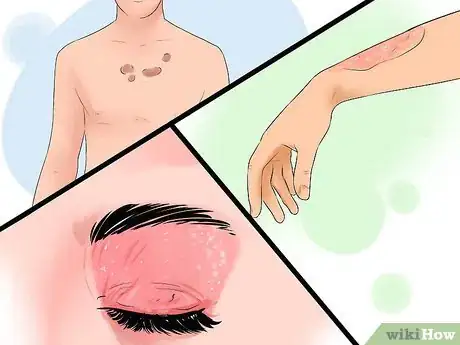
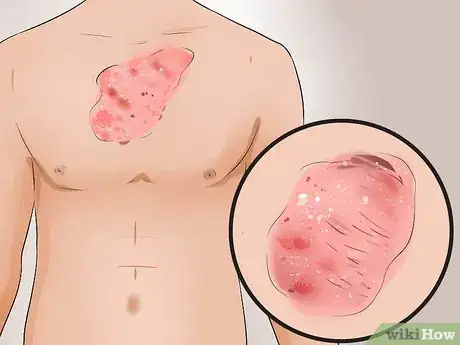


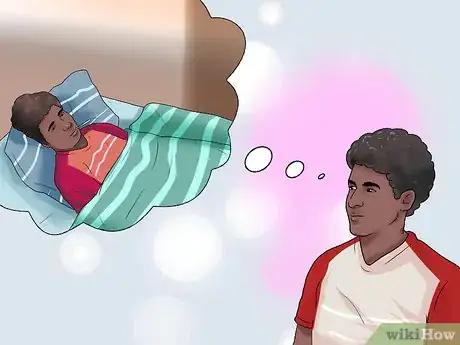

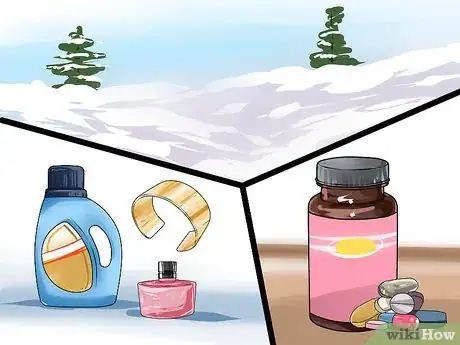
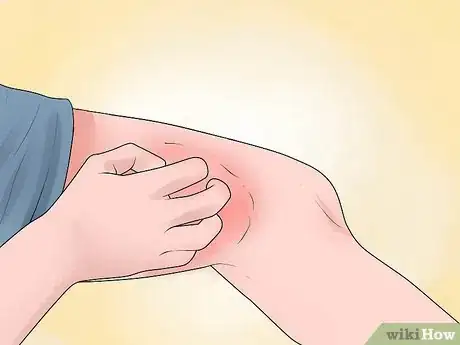

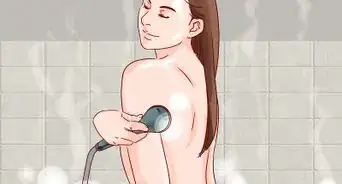





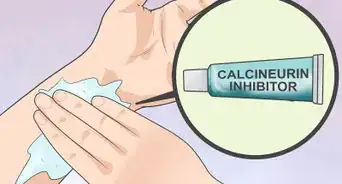














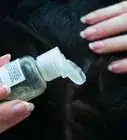




































Medical Disclaimer
The content of this article is not intended to be a substitute for professional medical advice, examination, diagnosis, or treatment. You should always contact your doctor or other qualified healthcare professional before starting, changing, or stopping any kind of health treatment.
Read More...